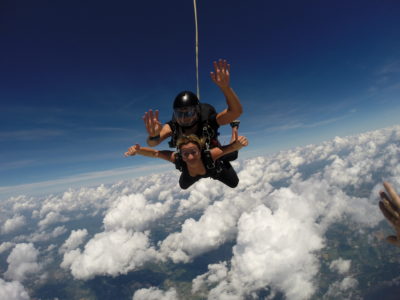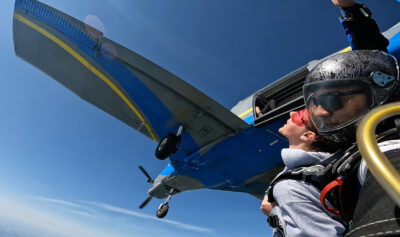- Michigan's Premier Skydiving Center
- Call Now: (517) 423-7720
How Does Weather Affect Skydiving?
Monday, June 26, 2023
- Skydive Tecumseh
- 6/26/23
- 0
- Blog, General
Every outdoor activity is forced to succumb to whatever elements the Earth brings, and skydiving is no different. When you are completely reliant on those weather conditions being fair, you may want to reconsider the activity if the weather decides to rain on your parade. So, what are the best skydive weather conditions, and what kind of weather can prevent you from skydiving? Let’s explore the impact of different weather conditions, wind limits, and what to do if the weather is looking less than promising on the day of your scheduled skydive.
Can You Skydive in the Rain?
Rain is one of the primary weather conditions that significantly affects skydiving, mostly because jumping from an aircraft in the rain is cause for major safety concerns – but also, rain flying at your face at 120 mph straight-up hurts! So, if you’re wanting to be safe and comfortable while on your skydive, it’s highly recommended to just avoid rainy days altogether, even the light stuff.
Rain can impair visibility, making it challenging for jumpers to navigate during freefall and accurately fly their parachutes in the right direction for a safe landing. Not to mention, the weight of the rain on the parachute has the ability to change how the parachute is supposed to fly, making it harder to control the canopy toward a safe landing.
Can You Skydive When It’s Cloudy?
 Cloud cover is another crucial factor that impacts skydiving. Low clouds are often a no-go for skydiving and that’s not just coming from us – the rules trickle down all the way from the big dogs. The Federal Aviation Administration (FAA) states that:
Cloud cover is another crucial factor that impacts skydiving. Low clouds are often a no-go for skydiving and that’s not just coming from us – the rules trickle down all the way from the big dogs. The Federal Aviation Administration (FAA) states that:
“No person may conduct a parachute operation, and no pilot in command of an aircraft may allow a parachute operation to be conducted from that aircraft –
- Into or through a cloud, or
- When the flight visibility of the distance from any cloud is less than that prescribed”
According to the Federal Aviation Regulation (FAR) Part 105.17, a skydiver or pilot must be able to see with an unobstructed view for 3 miles, and they must maintain a distance of 500 feet below clouds, 1,000 feet above clouds, and 2,000 feet horizontally away from clouds. In short, jumping when there are obstructing clouds in between the plane and the ground could not only be unsafe, it could be a federal violation (no, thanks!).
How can clouds affect skydiving?
Cloudy conditions can pose challenges in terms of visibility, both during freefall and parachute deployment/flight. Skydivers need to be able to see the ground from wherever they are, and they also need to have full spatial awareness to keep a lookout for other skydivers or flying objects. Clouds can increase the risk of collisions in freefall, unsafe landings, or landing off of the dropzone into unsafe territories.
Skydiving Wind Limits
Excessive winds, turbulence, and high wind gusts can be a substantial risk to skydivers. Skydiving operations adhere to specific wind limits that are measured at different altitudes. We can check the winds using the Automated Weather Observation System, Winds Aloft (a report generated by the FAA), or by using an in-house anemometer to measure the wind speeds/gusts on the ground. Turbulent or “swirling” winds, wind gusts at a 14kts spread, and excessive wind speeds at the determined exit altitude all can increase the risk for a skydive.
How can wind affect skydiving?
Excessive wind speeds have the potential to cause significant freefall and parachute drift, pushing skydivers further away from the dropzone and into hazardous areas, such as trees or buildings. Turbulent and gusty winds just above the ground can create dangerous rotors, making for a bumpy ride and an even more potentially dangerous situation that prevents you from controlling the parachute completely.
‘Tis the Skydiving Season
 When discussing the best skydive weather conditions, we can’t forget to mention the impact of skydiving in the summer vs skydiving when it’s cold.
When discussing the best skydive weather conditions, we can’t forget to mention the impact of skydiving in the summer vs skydiving when it’s cold.
During the summer, skies are usually clearer and the temperatures are much more favorable. Temperatures are 30-40 degrees cooler up at altitude, so remember that when you’re deciding when to book your jump or prepare your skydiving outfit.
The Best Skydiving Weather
So, what are we looking for? The ideal skydiving weather conditions should provide optimal safety and the best experience for skydivers in terms of visibility, safe landings, and comfortability. This is what our perfect skydiving weather forecast would look like:
- Clear skies, or minimal cloud cover
- Temps between 75-85 degrees
- 5 mph winds
That being said, it doesn’t have to be perfect to have an amazing and comfortable time.
What if the Weather is Too Bad to Skydive?
We think it’s safe to say that we collectively agree that weather can be extremely unpredictable and sometimes the forecast isn’t always accurate. For this reason, we typically won’t make any decisions until the day of your scheduled skydive. We understand that this can make it difficult to coordinate other plans, but we will always do our due diligence to keep you updated on the conditions as best we can. When we know, you’ll know!
If it is decided that the weather isn’t safe for jumping on the day of your scheduled skydive, we will simply reschedule your jump at your convenience. You will not lose any deposit money that has already been paid. We understand that rescheduling can be extremely disappointing, and we’re disappointed too – there’s nothing we want more than to get you up in the air! But what’s more important to us is your safety. Trust us, you’ll be so glad you waited for good weather.
Is your skydive weather forecast looking favorable? Don’t miss your opportunity – book your skydive with Michigan’s premier skydiving center, Skydive Tecumseh! Blue skies, friends.

I drove more than 2 hours to jump with Tecumseh because I wanted a reputable company and I was not disappointed. They were very safety minded and professional. The staff was very friendly and made the whole experience fun! If you're only doing it once, pay the extra and get the video package. Very well done, you won't be disappointed.
Ken Reeves
Copyright © 2025, Skydive Tecumseh, All Rights Reserved.
DropZone Web Design & Marketing by Beyond Marketing, LLC